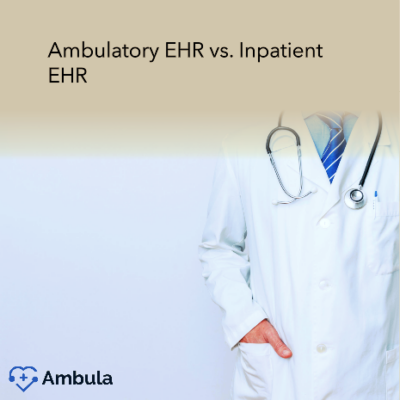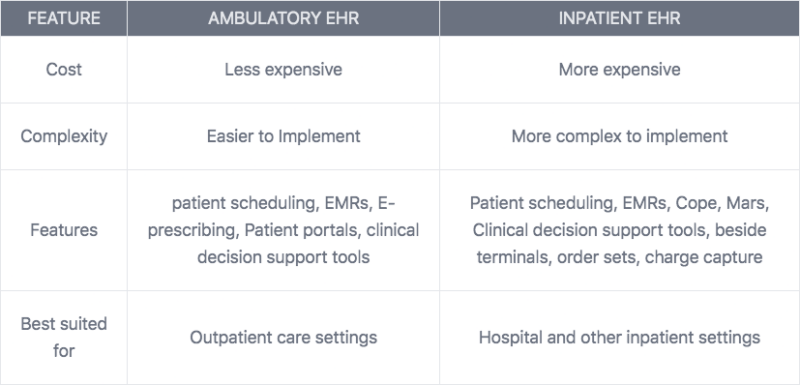
Electronic health records (EHRs) have revolutionized the way healthcare is delivered. EHRs have made it easier for doctors and other healthcare professionals to coordinate care, improve efficiency, and reduce errors by providing a secure and centralized location for patient data.
There are two main types of EHRs: ambulatory EHRs and inpatient EHRs. Ambulatory EHRs are designed for outpatient care settings like clinics and doctor’s offices. Inpatient EHRs are designed for hospitals and other inpatient care settings.
Features of Ambulatory EHRs
Ambulatory EHRs typically include the following features:
- Patient scheduling: Ambulatory EHRs allow you to schedule appointments and track patient demographics, such as name, address, and insurance information.
- EMRs: Ambulatory EHRs allow you to create and manage electronic medical records (EMRs) for your patients. EMRs include patient medical history, medications, allergies, immunizations, and other important information.
- E-prescribing: Ambulatory EHRs allow you to send electronic prescriptions to pharmacies. E-prescribing can help to reduce prescription errors and improve patient safety.
- Patient portals: Ambulatory EHRs often include portals allowing patients to access their medical records online. Patient portals can also send secure messages to providers and request prescription refills.
- Clinical decision support tools: Ambulatory EHRs may also include clinical decision support tools that can help you to make better-informed decisions about patient care. For example, clinical decision support tools can alert you about potential drug interactions or contraindications.
Benefits of Using an Ambulatory EHR
Ambulatory EHRs can improve patient care by providing increased accessibility, improved accuracy, better coordination of care, and enhanced clinical decision support.
Patients can access their medical records anytime, anywhere, through a secure patient portal. This can help them stay more informed about their health and make better decisions about their care. EHRs also help to reduce errors by automating tasks such as medication ordering and lab result entry. EHRs can also help you better coordinate care with other healthcare providers, such as specialists and hospitals. This can help to ensure that patients receive seamless care, regardless of where they go for treatment. Finally, EHRs can provide real-time information and alerts to help you make better clinical decisions. For example, an EHR can alert you to potential drug interactions or contraindications.
EHRs can also help you to reduce costs in several ways. First, they eliminate the need for paper charts, saving you time and money on printing, storage, and retrieval. Second, EHRs can help you to streamline your practice operations and improve efficiency. For example, you can use an EHR to schedule appointments electronically, send patient reminders, and generate reports. Finally, EHRs can help you improve your coding and billing accuracy, leading to increased revenue.
Overall, ambulatory EHRs offer several benefits for doctors and healthcare professionals. They can help to improve patient care, reduce costs, and improve practice satisfaction.
When to Choose an Ambulatory EHR
Ambulatory EHRs are a good choice for doctors and healthcare professionals who provide outpatient care services. They are especially well-suited for small and solo practices, as well as larger ones looking for a more affordable and flexible EHR solution.
If you’re a doctor or healthcare professional, you’re probably wondering whether you should choose an ambulatory or inpatient EHR system. Here are some things to consider:
- An ambulatory EHR system is probably the right choice if you’re a single practitioner or small practice. Ambulatory EHRs are designed for outpatient care, and they’re typically more affordable and easier to implement than inpatient EHRs.
- If you’re part of a larger practice or hospital system, you may want to consider an inpatient EHR system. Inpatient EHRs are designed to manage the complex needs of hospitalized patients, and they often have features not available in ambulatory EHRs, such as order entry, bed management, and discharge planning.
- If you’re not sure which type of EHR system is right for you, there are a few factors you can consider:
- What are your specific needs? Do you need a system that can handle specialized care, such as oncology or cardiology? Do you need a system that integrates with other systems, such as your billing or laboratory system?
- What is your budget? Ambulatory EHRs are typically more affordable than inpatient EHRs, but prices can vary depending on the features and functionality you need.
- What is your timeline? Some EHR systems are easier to implement than others. If you need a system up and running quickly, you may want to choose a system that is cloud-based or that has a rapid implementation process.
Features of Inpatient EHRs
Inpatient electronic health records (EHRs) are software systems that help hospitals and other inpatient care facilities manage patient data and streamline workflows. They offer a wide range of features that can improve the quality and efficiency of care, including:
- Patient demographics and medical history: Inpatient EHRs store all of a patient’s essential demographic information and medical history in one place, making it easy for providers to access and share this information quickly and easily.
- Orders and medication management: Inpatient EHRs allow providers to enter electronically and track orders for medications, tests, and other procedures. This helps to ensure that orders are accurate and complete and that patients receive the care they need on time.
- Clinical documentation: Inpatient EHRs provide a variety of tools for clinical documentation, such as note templates, order sets, and structured data entry. This can help providers to document patient care more efficiently and accurately.
- Reporting and analytics: Inpatient EHRs can generate a variety of reports and analytics that can be used to improve patient care and quality outcomes. For example, EHRs can be used to track trends in patient populations, identify areas for improvement, and measure the effectiveness of interventions.
Benefits of Using an Inpatient EHR
Inpatient electronic health records (EHRs) offer a number of benefits to doctors and healthcare professionals, including:
- Improved quality of care: Inpatient EHRs can help to improve the quality of care by providing providers with easy access to patient information, reducing errors, and streamlining workflows.
- Increased efficiency: Inpatient EHRs can help providers to be more efficient by automating tasks, reducing paperwork, and making it easier to share patient information.
- Reduced costs: Inpatient EHRs can help to reduce the cost of care by improving efficiency, reducing errors, and improving patient outcomes.
- Improved patient satisfaction: Inpatient EHRs can improve patient satisfaction by making it easier for patients to access their medical records, communicate with their providers, and get the care they need when they need it.
Choosing the Right EHR for Your Organization
Choosing the right Electronic Health Record (EHR) for your organization isn’t a decision to be taken lightly. It involves analyzing your organization’s needs, considering budget, and ensuring interoperability.
Step one: consider your organization’s unique needs. Every healthcare environment is different, so the EHR system should match your exact specifications. Are you a small practice, a large hospital, or a specialized clinic? Your choice should reflect your organization’s size and specialization. The Office of the National Coordinator for Health IT (ONC) states that well-matched EHR systems can improve healthcare quality by 88%.
You also ought to address your budget. EHR systems are an investment, but they should not break the bank. Define your budget first, then explore options that provide the services you need within that financial scope. A Cost-Benefit Analysis presented by the American Medical Association revealed that practices adopting EHR systems could save costs by approximately 47%.
Finally, focus on interoperability. It’s essential that the EHR system can effectively communicate with other systems, devices, or applications inside or outside the boundaries of your healthcare setup. This will assure smoother transitions of care and streamlined sharing of patient data.
So, keep these aspects in mind while settling on an EHR. Aligning it
Which Type of EHR Is Right for You?
If you’re a doctor or healthcare professional, you probably wonder which type of EHR is right for you. There are two main types of EHRs: ambulatory EHRs and inpatient EHRs.
Ambulatory EHRs are designed for outpatient care settings like clinics and doctor’s offices. They’re typically less expensive and easier to implement than inpatient EHRs. Ambulatory EHRs typically include patient scheduling, electronic medical records (EMRs), e-prescribing, patient portals, and clinical decision support tools.
Inpatient EHRs are designed for hospitals and other inpatient care settings. They’re more expensive and complex to implement than ambulatory EHRs but offer more features and functionality. Inpatient EHRs typically include features such as patient scheduling, EMRs, computerized provider order entry (CPOE), medication administration records (MARs), clinical decision support tools, bedside terminals, order sets, and charge capture.
Here’s a table to help you decide which type of EHR is right for you

If you’re still not sure which type of EHR is right for you, here are some additional things to consider:
- Your practice size. Ambulatory EHRs are a good choice for small and solo practices, as well as larger practices that are looking for a more affordable and flexible EHR solution. Inpatient EHRs are a good choice for hospitals and other inpatient care settings that need a robust EHR solution that can support the complex needs of acute and critical care patients.
- Your budget. Ambulatory EHRs are typically less expensive than inpatient EHRs. However, the cost of an EHR will vary depending on the features and functionality you need.
- Your desired features and functionality. Make a list of the features and functionality that are important to you. Then, compare different EHR systems to see which ones meet your needs.
- Your integration needs. If you use other healthcare systems, such as a practice management system or a laboratory information system, you’ll need to ensure your EHR can integrate with those systems.
Once you’ve considered all of these factors, you’ll be better positioned to choose the right EHR for your practice.
Conclusion
EHRs are an essential tool for doctors and other healthcare professionals. By choosing the right EHR for your organization, you can improve efficiency, reduce errors, and enhance patient care.




